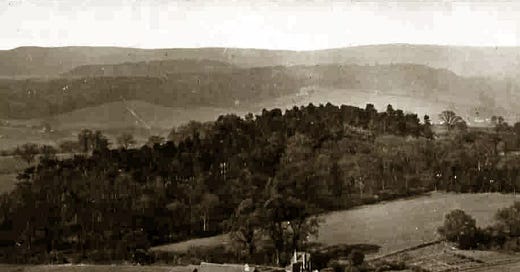Earlier this week I recorded a podcast about ‘The Disappearance’: that eleven-day period in Agatha Christie’s life, almost a century ago now, about which so much speculation has ensued. What happened? Why did it happen? Did Agatha lose her memory? Did she plan it all? Fictions and films have been woven around those eleven days, whose blank face presents an irresistible canvas. And this is Agatha Christie… the supreme writer of mysteries, who created the greatest of them all within her own life.
As I wrote in my Agatha biography:
No life is a code to be deciphered: there will always be gaps and inconsistencies, and it is stories that make the missing connections. Omniscience is for Hercule Poirot. Real life knows less; it has the beauty of mystery; and this, despite the books that she wrote, was something that Agatha understood very well.
First, some facts.
On the night of Friday, 3rd December 1926, Agatha - then aged 36; the poster above is wrong - drove away from her home in Sunningdale, Berkshire. Her Morris car, containing an old driving licence and other clues to her identity, was found the next morning some twenty miles away. It was at the edge of a quarry, about three hundred yards down a vertiginous slope, on the North Downs in Surrey.
On the evening of Tuesday, 14th December, acting on intelligence from hotel staff, police detectives travelled to the Harrogate Hydro in north Yorkshire. There they found Agatha, who had been staying at the spa hotel since Saturday the 4th, registered under the name of Mrs Teresa Neele.
I wrote about this eleven-day period at great length in my Agatha biography, because it seemed to me the turning point of her life - the hinge in it. As she put it in her 1967 novel Endless Night: ‘from then on it was as though a knife fell, cutting my life into two halves’.
Also, quite simply, it was such an extraordinary thing to do. Many of us may have longed to disappear, even just for a short time, but actually to carry it through….
One of my favourite short stories, The Enigma by John Fowles, is about disappearance. A middle-aged Conservative MP, landed gentry, family man - and then, one day, he vanishes. The story was published in 1974, the year in which disappearing became fashionable - John Stonehouse, Lord Lucan - and it has nothing directly to say about Agatha, except in the larger sense that it scrutinizes the will, or willingness, to disappear. The mystery that is thereby created, even if the disappeared person reappears. For they are changed, surely, by this period spent in absence, alive but essentially invisible, the walking talking breathing ghost of themselves. Why did they do it? How did they do it? What was it like, to be disappeared?
‘Nothing lasts like the unsolved’, is a line in Fowles’ story; I used it as the epigraph at the start of my biography.
I became profoundly engaged with this event in Agatha’s life, so obsessed in fact that I re-enacted it. On the evening of 3rd December 2005 I drove to the large, yew-tree-shrouded Sunningdale house - named ‘Styles’, after Agatha’s first published book - where she had lived with her first husband Archie and their daughter Rosalind. Then I drove off into the night. I was dressed, as I recall, in an approximation of Agatha’s clothes - not cosplay, just without the reassuring modern armour of jeans and boots - and I refused myself the consolation of music, or even Radio 4, as I wound through roads less familiar to me than they would have been to Agatha (but I had cat’s eyes to light my way - not used until 1934 - and an automatic car).
Then: Newlands Corner, the site on the North Downs where her Morris had left the A25, and descended to the edge of the quarry.
Keep reading with a 7-day free trial
Subscribe to Laura Thompson’s Substack to keep reading this post and get 7 days of free access to the full post archives.





